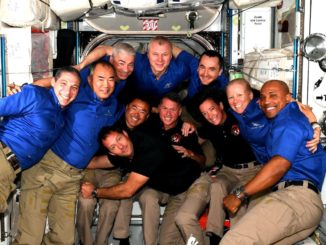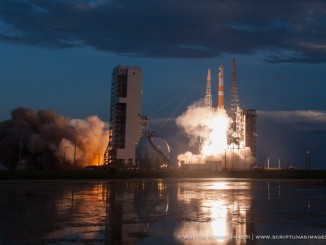
SpaceX continues to prepare for a launch attempt as soon as next week for the first test flight of its Super Heavy booster and Starship rocket, with final work on the ship’s self-destruct system, data reviews, and the receipt of an FAA license still to come before teams proceed into a countdown in South Texas.
Technicians removed the Starship upper stage from the top of the Super Heavy booster late Tuesday night and lowered it to ground level using two articulating “chopstick” arms on the nearly 50-story-tall launch pad tower as SpaceX’s launch facility, called Starbase, on the Texas Gulf Coast.
The “de-stack” was expected to allow SpaceX crews to complete work on the Starship’s flight termination system, which would be activated if the rocket veers off its pre-approved flight path. In such an event, the flight termination system’s pyrotechnic charge would destroy the rocket before it threatened populated areas.
SpaceX will stack the Starship back on top of the Super Heavy booster before the launch countdown. The fully-stacked vehicle stands 394 feet (120 meters) tall, larger than any rocket in history.
A cluster of 33 methane-fueled Raptor engines, each generating about a half-million pounds of thrust, will power the rocket off the pad for its inaugural test flight. Six Raptor engines are mounted to the Starship upper stage. Those engines will accelerate Starship to near orbital velocity, and the vehicle will coast around the world before falling back through the atmosphere over the Pacific Ocean, eventually impacting north of Hawaii.
But that assumes all goes according to plan on the test flight. SpaceX has performed several launches of Starship prototypes, but those flights remained inside Earth’s atmosphere. The Super Heavy booster, which stands taller than the Falcon 9 rocket SpaceX uses to launch crews to the International Space Station, has never left the ground.
The earliest the Super Heavy/Starship test flight could take off is early Monday, with a launch window opening around 7 a.m. CDT (8 a.m. EDT; 1200 UTC). But the actual launch date will depend on multiple factors, including technical readiness, weather conditions, and perhaps most apparent, the FAA’s approval of a commercial launch license.
Sources characterized the discussions regarding the launch license as a “back-and-forth” dialogue between the FAA and SpaceX, which must satisfy the FAA that it is complying with federal standards for environmental protection and public safety.
The Starship launch site is located east of Brownsville, Texas, a few miles north of the U.S.-Mexico border on Boca Chica Beach.
SpaceX plans to forego a final launch day dress rehearsal, which would have included loading methane and liquid oxygen into the two-stage launcher, just as they will be pumped into the vehicle during the real launch attempt.
“Teams are focused on launch readiness ahead of Starship’s first integrated flight test as soon as next week, pending regulatory approval,” SpaceX tweeted Tuesday.
There’s been no official update from the FAA this week, beyond public statements that the agency will “only make a determination after SpaceX meets all safety and other regulatory requirements,” an FAA spokesperson said.
The FAA, which is responsible commercial launch and re-entry operations by U.S. companies, announced last year that it will require SpaceX to take more than 75 actions to reduce the environmental effects of flying its Starship rocket from South Texas. But not all of the mitigation steps are required before the FAA issues a commercial launch license to SpaceX for the first Starship orbital test flight.
The FAA licensing process includes a series of reviews, including a policy review with other federal agencies, and a safety review to evaluate a launch operator’s approach to ensuring an accident would not harm the people or property owned by third parties. The FAA also requires launch companies to obtain insurance to cover third-party claims in the event of a catastrophic launch failure.
Email the author.
Follow Stephen Clark on Twitter: @StephenClark1.



